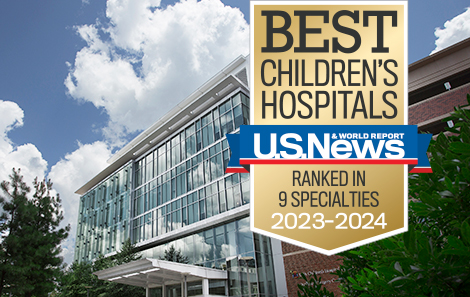Hearing that your child has an optic nerve glioma is terrifying. You have a lot of questions about what treatment looks like, what caused it, and what the next steps are.
Because this type of brain tumor is so slow-growing, it only becomes noticeable when your child's vision worsens. The most important thing to remember is that this type of tumor is very treatable.
Treating Optic Nerve Gliomas at UVA Health Children's
UVA Health Children's can help your child get the treatment they need fast. That means your child will have a better outcome.
Your child's doctor will start with imaging and other needed tests. The results of these help us figure out the best treatment options for your child.
Surgery for Optic Nerve Gliomas
Some tumors are small enough that they can be removed in one surgery.
But for many others, a staged approach is the better option. When we use this approach, part of the tumor is removed at first. Then the remaining piece is shrunk using targeted chemotherapy or radiation. Then, another surgery removes what is left of the tumor.
Although the idea of more than one surgery may sound scary, using shorter surgeries that are less traumatic to your child's body is often better. Your surgeon will talk to you after checking your child's tumor and forming a plan.
Gamma Knife for Optic Nerve Gliomas
Gamma knife therapy is a way of treating brain tumors that doesn't involve surgery. At UVA Health Children's, we've offered this option since 1989. By using targeted radiation, we can often treat brain tumors without having to open your child's skull.
Chemotherapy
Chemotherapy drugs target and kill cancer cells. Although chemo can have side effects, we've found that it's a good option for treating optic nerve gliomas in kids. Our dietitians, occupational therapists, and the rest of our care team will help to care for any side effects as they happen.
Support During Treatment
We also have resources to help support your child and family during treatment.
Our child life specialists can help explain your child's condition in a way that makes sense to them. Social workers can help you find other types of community support. And our school program makes sure that your child's development doesn't suffer due to their condition. We can also help you find a place to stay during treatment.
Your Child's Care Team
Optic nerve gliomas are one of the many types of brain tumors that we treat at UVA Health Children's. Treating brain tumors requires experience, cutting-edge equipment and research, and many specialists. Your child's care team may include:
Together, these specialists offer your child the best quality care. Most of the time, treating optic nerve gliomas means using several approaches that work together.

The #1 Children's Hospital in Virginia
For 3 years, UVA Health Children's has been named the best children's hospital in Virginia. We have equipment that's right-sized for our patients. Doctors who understand the unique struggles of treating very young patients. And services including child life specialists, social workers, and emotional support for families.
Optic Nerve Glioma FAQs
What caused my child to have an optic nerve glioma?
Sadly, there is no good answer for why. It's not clear how people get them. You could not have prevented this.
Who's at risk for optic nerve gliomas?
Optic nerve gliomas are more common in children who have a genetic condition called neurofibromatosis 1 (NF1). We can test your child at our genetics clinic to see if they have this condition. The outcome for children with NF1 and an optic nerve glioma is even better than the average.
What's the survival rate for optic nerve gliomas?
Survival rates are affected by several things. Your doctor can talk to you about what your child can expect in more detail.
But the survival rate is generally very good, right around 90%.
What symptoms are caused by optic nerve gliomas?
Usually worsening vision, a swollen eye, or hormonal problems leading to rapid weight gain or weight loss. These symptoms generally go away after treatment.


